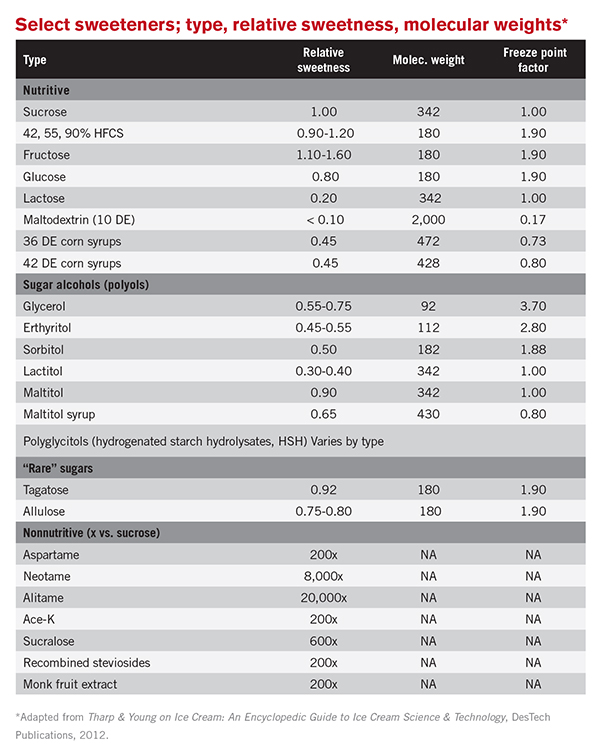Sweeteners of all types are used in frozen desserts for a variety of straightforward reasons:
- Sensory appeal.
- Management of mix freezing-point depression, aeration/whipping, freezing and water-mobility control.
- Viable source(s) of low-cost “nonfat” solids.
- Benefits to body/texture and water mobility control.
- Management of yield.
Buried in the above are issues related to what sweeteners are available, their relative sweetness compared to each other and their cost in use.
Some time back, we introduced the concept of “cost per unit sweetness” (CUS) to allow comparison of any combination of sweeteners relative to economic considerations. Since then, many new sweeteners have been approved for use, and markets for nearly all sweeteners have changed dramatically. Even so, CUS still applies when considering one or more sweeteners for use in frozen desserts.
Sweeteners of any type must be generally recognized as safe (GRAS), and are typically classified as either nutritive (providing solids with varying caloric contributions) or nonnutritive (i.e., high-intensity sweeteners used at such low levels they provide neither solids nor calories).
The table lists select sweeteners, their relative sweetness versus sucrose and their molecular weights. The latter is used to calculate relative freezing point considerations, secondary influences on whipping/freezing during manufacturing and negative effects on freeze/thaw and body/textural elements through the full intended shelf-life of the finished frozen dessert.
At any given time, more than 65 to 70 individual sweeteners may be available from which to choose for any given set of objectives in the final frozen dessert. So the question becomes how to best evaluate and select the right sweetener or combination of sweeteners.
Answers lie within the ultimate objectives/declarations to be made about the final frozen dessert (e.g., reduced sugars, no sugars added or even true sugars-free, reduced calories) and compatibility of quality/intensity of sweetness with any given characterizing flavor. That is, comparing sweeteners, and combinations thereof, with the cost of the most common factor being applied: sweetness. CUS can help and can be calculated ignoring may other factors.
Example A. CUS = sucrose (dry) = $0.30 USD (cost per pound of dry sucrose)/unit sweetness (i.e., sucrose = 1.00) = $0.30 USD per unit sweetness.
Example B. CUS = HFCS*-42 (dry) = $0.20 USD (cost per pound dry solids)/unit sweetness. HFCS-42 has a relative sweetness of 0.90 (i.e., may need 5-10% more on dry basis to achieve the same sweetness intensity as sucrose). Assuming this to be the case, CUS = $0.20 USD/0.90 = $0.22 USD per unit sweetness.
CUS offers guidance as a comparative tool in ways similar to calculations of theoretical sweetness, freezing point depression, the amount of water frozen at any given temperature below the freezing point of the mix, and other factors. Thus, CUS is another relative factor to apply when making formulation-related judgements and decisions.
Novel approaches to formulation opportunities are now possible. Some of those include:
- Use of low-CUS high-intensity sweeteners (and combinations thereof) for basic cost reduction.
- All-natural no-sugars-added objectives while retaining sensory appeal and acceptable influences on whipping/freezing, resistance to heat shock, ingredient cost objectives and yield improvements.
- Mix management opportunities with more sucrose-like sweetness delivery via flavorings such as liquid concentrates, particulates and/or syrup inclusions.
Finally, it is important to keep in mind what is wished to be declared about the finished ice cream. Further, not all sweeteners are the same under the new “Added Sugars” regulatory considerations, and care is needed when selecting any given sweetener(s) to use. Despite all this, CUS remains applicable.



